Stop picking on the small kids in the performance car class!
If I were to tell you that the first two months of 2021 saw the unveiling of not one, but two rear-wheel-drive sedans with 472 horsepower on tap – one of which is using a 5.0-liter naturally aspirated V8 to do so – you’d likely think the new decade was shaping up to be one in which the BMW M3 might finally have met its match. But what if I then told you that both of these sedans, each within a single horsepower of the mighty M3, had absolutely no intention of rivaling it. Instead, the manufacturer of one claims that its creation is a rival to the 382-hp BMW M340i, while the other has decided that it would rather use a bi-turbo V6 to hunt down the Mercedes-AMG CLA 45 – a subcompact sedan with front-wheel-drive underpinnings. In my humble opinion as a car writer, this is tantamount to an eighth-grader playing ball with the seventh graders because he’s too scared to go up against his own classmates.
You’ll of course know that I’m referring to the Cadillac CT4-V Blackwing and brand spanking new Lexus IS 500 F Sport, both of which should, in theory, be M3 equals, but neither of which are willing to step up to the plate.
In the case of the Blackwing Caddy, there’s a sliver of evidence to suggest that the CT4 is actually a Mercedes CLA rival. Although it was technically built to replace the Cadillac ATS, by retaining the GM Alpha 2 platform of the ATS, it inherited a short wheelbase that makes it smaller than a contemporary 3 Series or 2022 Mercedes-Benz C-Class. Cadillac retained this platform because of its inherent driving dynamics – it was a rear-wheel-drive base through which the brand had built a genuine M3 fighter in the ATS-V, a base which was benchmarked against the sweetest of drivers’ 3 Series, the E46. Its body may be nearly as long as an M3, but the interior proportions are closer to those of the CLA 45. But, that was a choice made by Cadillac to not develop a new platform; a choice to package a 3 Series rival on an aged, compact platform.
 Cadillac
Cadillac
 Cadillac
Cadillac
 Cadillac
Cadillac
I take exception more with what Cadillac chose to power the CT4-V Blackwing. In what world does a 472-horsepower, 445-lb-ft twin-turbo V6 sedan – with a torque output that’s 39 b-ft higher than the base M3 – have any right to claim a 382-hp 2.0T as its chief rival? The CLA 45 is targeted at rivals like the 394-hp Audi RS3, and in both cases, both vehicles have roots in true compact commuters – machines whose underpinnings, in the case of the Audi, are shared with the humble VW Golf. It may be an oversimplification of the matter, but Cadillac has taken a platform used to rival the previous M3, given it an engine that matches the displacement and base power of the new M3, and is comparing it to a class of vehicle that is the same size and has the same starting point as the VW Golf.
 Cadillac
Cadillac
 Cadillac
Cadillac
 Cadillac
Cadillac
Instead, Cadillac claims the CT5-V Blackwing is its M3 rival, but the American playground bully has rocked up to the fight sporting a 668-hp, 659-lb-ft supercharged 6.2L V8 engine, figures that usurp the M3 Competition by a whopping 165 hp and 180 lb-ft. Even the BMW M5 is left wanting, falling 68 hp and 106 lb-ft shy. Cadillac will again spin the story that the CT5’s platform is smaller (read: older) and is thus not an M5 rival, and that both the CT4-V and CT5-V Blackwing are much cheaper than their German compatriots. But they always have been cheaper, because they’ve never been able to match the same levels of quality and luxury. The fact remains that Cadillac is choosing smaller, weaker rivals to inflate its own ego. It’s a typical case of a bully picking on the small kids because they aren’t confident enough to take on the big kids.
 Cadillac
Cadillac
 Cadillac
Cadillac
 Cadillac
Cadillac
 Cadillac
Cadillac
To Lexus’s credit, the Japanese brand hasn’t gone quite as far. At least the IS 500 is still targeted at vehicles of the same size, with the Japanese manufacturer targeting the BMW M340i, Mercedes-AMG C43, and Audi S4 as its chief rivals. All of these feature turbocharged 3.0-liter six-cylinder engines with power outputs ranging from 349 hp to 385 hp and torque from 368 lb-ft to 384 lb-ft. Brutishly, the Lexus IS 500 packs an extra 2.0 liters of displacement with a further two cylinders, with the result being 472 horsepower – M3 territory – and 395 lb-ft of torque. It’s precisely the same engine as you’ll find in Lexus’s own proclaimed M4-fighter, the RC F, meaning it’s not really a fair fight for the semi-AMG and semi-M models from German rivals. Lexus might be picking fights with kids in its own class, but it’s still finding the scrawnier ones to pick on – a quarterback picking a fight with the captain of the chess club.
Lexus is purposefully targeting weaker machines, but it’s something that speaks to a bigger issue for the Japanese brand: Lexus hasn’t developed a new engine or chassis architecture in a long time. The IS might just have been updated but the base platform is that of the 2014 model. Likewise, this engine has been in use since 2007 when it debuted in the Lexus IS F. The IS 500’s architecture is old and bloated, and the engine – while wonderfully sonorous and characterful – is old, and crucially, lacks torque. At 395 lb-ft it’s 11 lb-ft down on the M3 and a fairly hefty 84 lb-ft down on the base AMG C63. It’s an old piece of tech under the hood of the IS 500, so while the model designation might be new, the IS 500 is effectively a decade-old car trying to run with much newer machinery. Lexus knows it, and in lieu of that, it would rather pick on the weaker members of the class – a typically insecure bully mentality.
For Lexus at least, a change is coming. The restructuring of its performance models leaves the door open for a new range-topper that embraces turbocharging, but if the rumored bi-turbo V8 does come to fruition, then like the CT5-V Blackwing, Lexus will be juicing up on steroids heavily only to pick on smaller prey.
Ultimately, there will always be two sides to the coin. On the one side, some might say that both Lexus and Cadillac are playing it humble; not making bold assertions of “M3 Killers” only to be slaughtered by journalists and buyers alike. But in doing so, it seems like they’re both being complacent, happy to pick on the little guy and not deliver true like-for-like rivals of genuine competence. In my books, that’s taking the easy way out, and in my books, that’s nothing more than being a bully.





